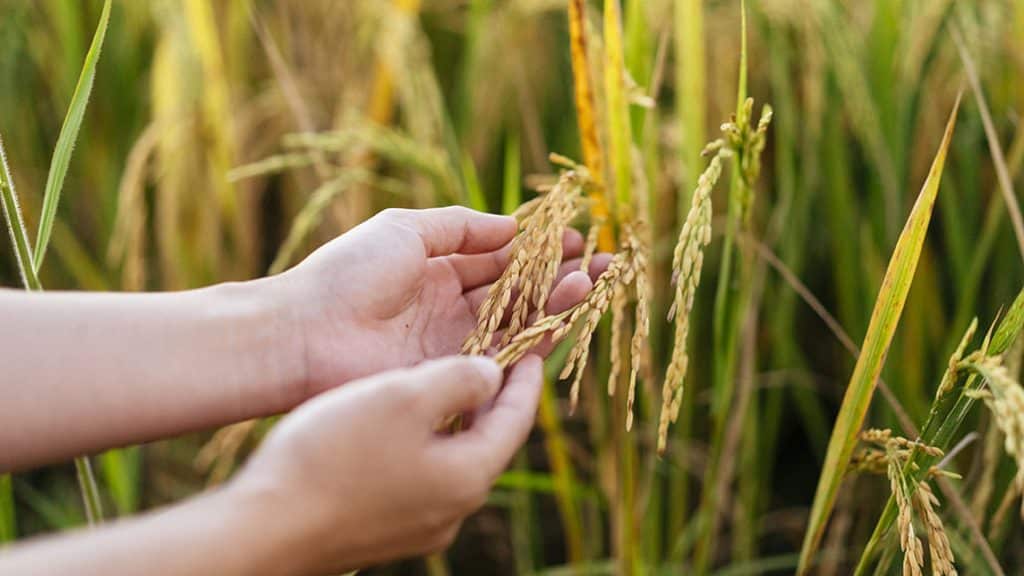Tags
Gene editing may help rice better withstand climate change
A teen researcher tweaked three genes that limit rice’s ability to withstand dry or salty conditions

Rice makes up a major portion of many people’s diets. But climate change is making it harder to grow this grain. At the Regeneron ISEF competition, Nandini Rastogi showed that using the gene-editing tool CRISPR could make rice better able to withstand harsh growing conditions.
By McKenzie Prillaman
LOS ANGELES, Calif. — Rice is a global dietary staple. Almost half the world eats it regularly — sometimes every day. But climate change has been making it harder to grow that grain. So Nandini Rastogi, 18, has just showed one way to make the plant more resilient to climate stress: She altered its DNA.
A rising senior, Nandini is homeschooled in Monroe Township, N.J. She showcased her work last month, here, at the Regeneron International Science and Engineering Fair (ISEF). This competition is a program of the Society for Science (which also publishes this magazine).
Stress — including extreme hot and dry climates — trigger certain biological processes in rice plants. These turn on physical changes in the plant that help it survive. In a drought, for instance, a plant may elongate its roots in search of more water. It might also close the tiny holes in its leaves to hold onto what water it does have.
Most of the time, those growth-promoting processes are turned off. Nandini decided to get rid of the genes that stopped these from turning on. That left the growth processes active, even when the plant wasn’t stressed. The teen tweaked rice cells using a gene-editing tool called CRISPR. It works like a molecular scissors.

Stressing out rice
Nandini started by growing almost 600 rice seedlings at a local lab for grade-school students. It’s called Yard Sciences.
The teen grew the plants in a mix of water and nutrients until they were 5 centimeters (about 2 inches) tall. Then she transferred some of the seedlings to a new mixture. It contained acids that would definitely trigger the plants’ stress response. Other seedlings received one of two chemicals to simulate a drought (polyethylene glycol or mannitol). Both dehydrate plants. Another rice group received salty water. Still another was grown at an extreme temperature — a chilly 4º Celsius (39º Fahrenheit). Nandini grew one last group of seedlings without any of these stressors.
Nandini looked at whether certain genes were active. She began this at the start of the trial and looked again 12 hours, 24 hours and 48 hours later. Genes regulate when certain processes turn on in cells. Those, in turn, lead to a lot of changes in plants. These include ones that can make them better able to withstand tough growing conditions.
Three genes became highly active in all experimental groups except the cold-stress condition. “This could be because extreme cold and extreme hot could actually have their own separate pathways,” Nandini says.
The teen then used CRISPR to cut out these three gatekeeping genes. “Because of strict government regulations,” she says, “I’m not actually allowed to perform gene edits on live plants.” So she instead edited the genes of cells that she had removed from the rice plants.
Searching for signs of resiliency
Nandini worked with around 450,000 plant cells. She viewed the cells with a special microscope. This let her confirm that the CRISPR “scissors” had gotten inside treated ones.
Every CRISPR scissors contained a protein. It glowed green when viewed through the microscope. The cells’ chloroplasts — which convert sunlight into plant food — appeared red. The two colors overlapped in the microscope images. This showed that the CRISPR tool had gone where it was supposed to.
Then to see if it had snipped out the target genes, Nandini looked for signs of what should happen if the gatekeeping genes were not there: for a certain pathway to start up. That pathway would activate certain proteins or change other parts of the cells. “These components are the ones that actually then go and make the rice more stress tolerant,” Nandini explains.
And some of these downstream components did, indeed, become active.
“That tells us that if we were to perform the edits on the live plant, there would be an increase in stress tolerance,” Nandini says. Hopefully, this would allow the rice to grow better under tough conditions. She walks through the specific details of her work in a video at this site.
The teen is now seeking approval to experiment on living rice plants. In the future, she hopes to expand her work to other important crops, such as corn. She’d also like to test more stress factors and biological pathways.
Nandini was among nearly 2,000 high school finalists, this year, who competed from almost 70 countries, regions and territories. Regeneron ISEF, which doled out more than $9 million in prizes at the event, has been run by Society for Science since it created the annual event in 1950.
https://www.snexplores.org/article/regeneron-isef-2024-gene-editing-rice-climate-changePublished Date: June 12, 2024






